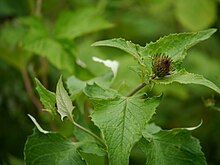
Back قسط هندي Arabic قسط هندى ARZ Saussurea costus AST قابیرغالی قالخان اوْتو AZB কোথ (উদ্ভিদ) Bengali/Bangla Chrpovník lopuchový Czech Indische Kostuswurzel German Saussurea costus Spanish Saussurea costus French Pucuk ID
| Dolomiaea costus | |
|---|---|

| |
| Scientific classification | |
| Kingdom: | Plantae |
| Clade: | Tracheophytes |
| Clade: | Angiosperms |
| Clade: | Eudicots |
| Clade: | Asterids |
| Order: | Asterales |
| Family: | Asteraceae |
| Genus: | Dolomiaea |
| Species: | D. costus
|
| Binomial name | |
| Dolomiaea costus | |
| Synonyms[2] | |
| |
Dolomiaea costus,[3] formerly known as Saussurea costus, commonly known as costus, Indian costus, kuth, or putchuk,[4] is a species of thistle in the genus Dolomiaea native to South Asia and China. Rishi (Hindu) mystics of Kashmir especially ate this plant. Essential oils extracted from the root have been used in traditional medicine and in perfumes since ancient times.[5][6]
Costus is the root of this plant. The root of the plant is the key part used for medicinal or homeopathic purposes.[7] The root is also called by its Latin name radix aucklandiae (root of aucklandia).[8]
It has a large number of names in other languages, including kuṣṭha in Sanskrit; kust or qust in Arabic and Persian; kut, kur, and pachak in Hindi and Bengali, kostum, gostham, and potchuk in Tamil; upaleta and kur in Gujarati; kot or kust in Punjabi; changala in Telugu; sepuddy in Malayalam; kostha in Kannada; kuth or postkhai in Kashmiri; and kosht (קשט) in Hebrew; koto in Swahili; mu xiang in Chinese.[9][10][11][12]
- ^ "Appendices | CITES". cites.org. Retrieved 2022-01-14.
- ^ "Dolomiaea costus (Falc.) Kasana & A.K.Pandey". Plants of the World Online. Kew Science. Retrieved 2021-07-24.
- ^ Kasana, Shruti; Dwivedi, Mayank D.; Uniyal, Prem L.; Pandey, Arun K. (2020-06-25). "An updated circumscription of Saussurea (Cardueae, Asteraceae) and allied genera based on morphological and molecular data". Phytotaxa. 450 (2): 173–187. doi:10.11646/phytotaxa.450.2.3. ISSN 1179-3163. S2CID 225739668.
- ^ Oxford English Dictionary, 3rd edition, 2007, s.v.
- ^ Birgit Lohberger; Beate Rinner; Nicole Stuendl; Heike Kaltenegger; Bibiane Steinecker-Frohnwieser; Eva Bernhart; Ehsan Bonyadi Rad; Annelie Martina Weinberg; Andreas Leithner; Rudolf Bauer & Nadine Kretschmer (2013). "Sesquiterpene Lactones Downregulate G2/M Cell Cycle Regulator Proteins and Affect the Invasive Potential of Human Soft Tissue Sarcoma Cells". PLOS ONE. 8 (6): e66300. Bibcode:2013PLoSO...866300L. doi:10.1371/journal.pone.0066300. PMC 3682952. PMID 23799090.
- ^ A.V.S.S. Sambamurty (2005). Taxonomy of Angiosperms. I. K. International Pvt. Ltd. p. 417. ISBN 9788188237166.
- ^ Davidson, Tish. "Aucklandia." The Gale Encyclopedia of Alternative Medicine, edited by Laurie J. Fundukian, 4th ed., vol. 1, Gale, 2014, pp. 197-198. Gale Virtual Reference Library, Accessed 20 Nov. 2017.
- ^ Chu, Chia-Yu; Ho, Po-Han; Cho, Yung-Tsu (2019). "Radix Aucklandiae (Dried root of Saussurea costus)-induced acute generalized exanthematous pustulosis confirmed by patch testing". Dermatologica Sinica. 37 (2): 98. doi:10.4103/ds.ds_16_18. S2CID 195096607.
- ^ Chandra P. Kuniyal, Yashwant S. Rawat, Santaram S. Oinam, Jagdish C. Kuniyal and Subhash C. R. Vishvakarma (2005). "Kuth (Saussurea lappa) cultivation in the cold desert environment of the Lahaul valley, northwestern Himalaya, India: arising threats and need to revive socio-economic values". Biodiversity and Conservation. 14 (5): 1035. Bibcode:2005BiCon..14.1035K. doi:10.1007/s10531-004-4365-x. S2CID 43549529.
{{cite journal}}: CS1 maint: multiple names: authors list (link) - ^ K. Madhuri; K. Elango & S. Ponnusankar (2011). "Sausaria lappa (Kuth root): review of its traditional uses, phytochemistry and pharmacology". Oriental Pharmacy and Experimental Medicine. 12 (1): 1–9. doi:10.1007/s13596-011-0043-1. S2CID 15514235.
- ^ Cite error: The named reference
amerwas invoked but never defined (see the help page). - ^ "Todd Caldecott | Kushta". Archived from the original on 2011-06-16. Retrieved 2011-01-15.